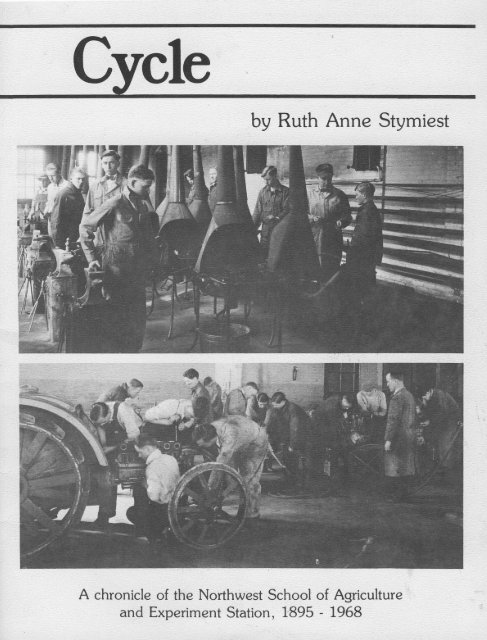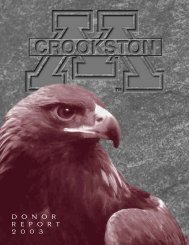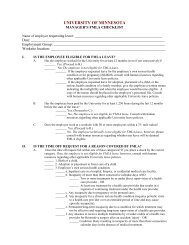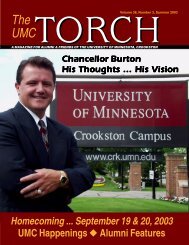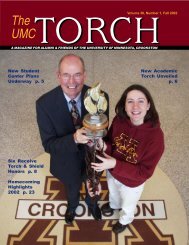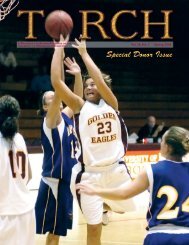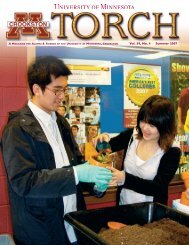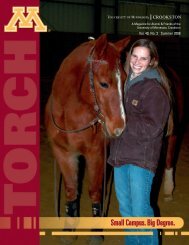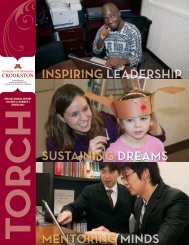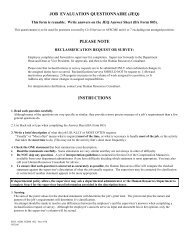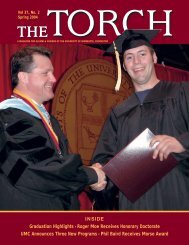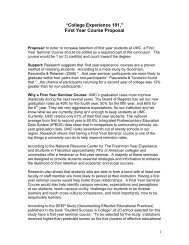Cycle - University of Minnesota, Crookston
Cycle - University of Minnesota, Crookston
Cycle - University of Minnesota, Crookston
Create successful ePaper yourself
Turn your PDF publications into a flip-book with our unique Google optimized e-Paper software.
__CIc_le_by Ruth Anne StymiestA chronicle <strong>of</strong> the Northwest School <strong>of</strong> Agricultureand Experiment Station, 1895 - 1968
<strong>Cycle</strong>ABOUT THE AUTHOR:RutA Anne Stymiest joined the UMC <strong>University</strong> Relations staff as apublicist in September <strong>of</strong> 1972. Included in her writing duties is the monthlypublication <strong>of</strong> UMC Inside Out. Spurred on by the interesting history <strong>of</strong> theNorthwest Experiment Station and the Northwest School <strong>of</strong> Agriculture,"Glimpses from the Past" became a special section <strong>of</strong> Inside Out for manymonths. Ms. Stymiest enjoys gathering historic information. and <strong>Cycle</strong> is aresull <strong>of</strong> thaI inleresl.A graduate <strong>of</strong> South Dakota State <strong>University</strong>', Ms. Stymiest holds abachelor <strong>of</strong> science degree in journalism with a minor in English.ABOUT THE DESIGNER:John C. Zak has been with UMC <strong>University</strong> Relations as assistant editor,publications, since September 1976. As a graphic designer andphotographer he saw the potential <strong>of</strong> a work chronicling the history <strong>of</strong>lJMC's forerunner. He actively pursued the idea during the winter <strong>of</strong> 77· 78.and enlisted the skills <strong>of</strong> Ruth Anne Stymiest. who had previously writtenabout the Northwest School for Inside Out. Mr. Zak contacted HerschLysaker and Berneil Nelson. who provided valuable background materialand in,i'.lhts. and located the historic photographs for this publication.A graduate <strong>of</strong> Bemidji State <strong>University</strong>. Mr. Zak holds a bachelor <strong>of</strong>science degree in mass communications and a master <strong>of</strong> science degree inindustrial education.Table <strong>of</strong> contents2. Station superintendents - the leaders4. The first years (1895-1905)5. The School begins (1905-1911)6. Years <strong>of</strong> growth (1911-1917)8, The first war years (1917-1919)9. Plans and problems (1920-1930)12. The Depression years (1930-1936)14. Toward stability (1937-1941)15. Another war (1941-1945)17. Time <strong>of</strong> hope (1946-1949)19. Toward a new era (1950-1959)<strong>Cycle</strong> is published by the Office <strong>of</strong> <strong>University</strong> Relations. <strong>University</strong> <strong>of</strong>Minl",sota Technical College. <strong>Crookston</strong>, MN 56716. Printed in U.S.A. byUMC Learning Resources. \
4The first years (1895-1905)<strong>Crookston</strong> had been on the <strong>Minnesota</strong> map for just afew years (it was incorporated in 1879) before plans wereunder way to locate an experiment station in the area.A substantial portion <strong>of</strong> the credit goes to WiIlet M. Hays<strong>of</strong> the <strong>Minnesota</strong> Experiment Station at St. Anthony Park.Hays was pr<strong>of</strong>essor <strong>of</strong> agriculture and agriculturist at theexperiment station <strong>of</strong> North Dakota Agricultural College,Fargo, in 1892 and 1893. He traveled widely on both sides<strong>of</strong> the Red River Valley. He was impressed with the idea <strong>of</strong>"spreading the <strong>University</strong>" to different parts <strong>of</strong> the state.When Hays joined the <strong>Minnesota</strong> Experiment Station, hereceived a general consent from the Agricultural Committee<strong>of</strong> the Board <strong>of</strong> Regents to make a survey <strong>of</strong> <strong>Minnesota</strong> toconsider beginning the development <strong>of</strong> regional stations andschools.First station superintendent, T. A. Hoverstad, poses at theNorthwest Experiment Station with one <strong>of</strong> the stationhorses.Because <strong>of</strong> its unique geological attributes, the RedRiver Valley was selected as one <strong>of</strong> two locations forconsideration in <strong>Minnesota</strong>. Polk County's senator at thattime was Peter M. Ringdal <strong>of</strong> <strong>Crookston</strong>. Ringdalintroduced a biIl for the establishment <strong>of</strong> an experimentstation to be located near <strong>Crookston</strong>. At the same time,House <strong>of</strong> Representatives member M.E. Craig, introduced abiIl to establish an experiment station in the northeasternpart <strong>of</strong> the state. The two worked together, coming up withtwo identical biIls that included both stations in both theSenate and the House bills. The 1895 legislatureappropriated $30,000 to procure equipment and toconduct two sub-experiment farms, one at Morris and oneat <strong>Crookston</strong>.Several tracts <strong>of</strong> land were considered for the NorthwestExperiment Station location. It was finally located by theBoard <strong>of</strong> Regents at <strong>Crookston</strong> on land donated by theGreat Northern Railway under the auspices <strong>of</strong> PresidentJames J. HiIl and Samuel Hill. Hill <strong>of</strong>fered the land to WiIletHays before the Board <strong>of</strong> Regents had formally consideredthe project. When Hays protested, HiIl said to him, "Youngman, you go ahead."The land donated near <strong>Crookston</strong> consisted <strong>of</strong> 476.61acres. It was unimproved land, and it posed a considerabledrainage problem. The land selected was extremely low, butit was regarded as advantageous to have such a tract <strong>of</strong> landfor experimental purposes and for investigational use.Work at the farm began in 1895. The city <strong>of</strong> <strong>Crookston</strong>and Polk County each gave $1,000 which was utilized fordrainage work and for making roads around and throughthe Northwest Farm. Hays was given gene'ral charge <strong>of</strong> theequipment and plans, and T.A. Hoverstad was selected tobe superintendent <strong>of</strong> the station.As a portent <strong>of</strong> things to come, the first implements thatwere unloaded, along with horses and other farm materials,were soon soaked with rain. The man in charge <strong>of</strong> gettingthe first supplies to the station slept in an old barn during thenight. When he woke in the morning, after a night <strong>of</strong> rain,he looked out and saw only one or two spots <strong>of</strong> the farmabove water. <strong>Crookston</strong> residents referred to the land as the"duck pond," <strong>of</strong>ten mentioning the fact that the area was aperfect place to "bag" ducks.Conditions weren't favorable. The spring <strong>of</strong> 1896 wasextremely wet. Rainfall was so constant and excessive that itwas difficult to plant crops in time for a growing season. In1897, floods just before harvest nearly ruined the wheat andoats. A fire caused by lightning that year destroyed the barn,several horses and several farm tools and conveyances. In1899, planting was delayed until late May and early June,and a hail storm came just before harvest. Unseasonablywet years followed until 1905. The main consideration wasto secure a suitable drainage system.The state legislature appropriated $5,000 in 1903 fordrainage. The ditching that followed removed some <strong>of</strong> thesurface water problems, but the ditches weren't <strong>of</strong> sufficientcapacity to remove water quickly after heavy rains or duringspring thaws. In 1905, an additional appropriation <strong>of</strong>$4,000 was made to be used for more drainage and forexperimenting with tile drainage. The seasons <strong>of</strong> 1906,1907 and 1908 were given up entirely to ditching and layingtile. The ditch was completed by 1909, and consisted <strong>of</strong>about 50,000 feet <strong>of</strong> tile plus a one and one-half mile openditch.With the drainage problem under control, more researchand experimentation could be done in other vital areas <strong>of</strong>agriculture, dealing with crops, livestock and horticulturalwork.
Summer practicums were established procedures by1912. The theory was, students would attend school for sixmonths and pursue a "practicum," or as it was later known,a "home project," at home or on the farm for the other sixmonths <strong>of</strong> the year.Following the advice <strong>of</strong> <strong>University</strong> President George E.Vincent, that there be "no blind alleys in our schools," theNorthwest School <strong>of</strong>fered a fourth-year advanced course,which focused totally on academic studies.A central heating plant was constructed in 1913, and by1914 construction was begun on a second boys' dormitory.In addition to Superintendent Selvig, there were 15 facultymembers employed at the school by 1914. Selvig noted, "Isought the best teachers and Station staff members procurable.Most <strong>of</strong> them were young, but they were wellprepared. They grew in stature with the years. To them isdue full credit. The work was hard. During the early yearssalaries were low."School activities continued to expand. Music, publicspeaking, debating, Young Men's and Young Women'sChristian Activities, athletics and other activities wereadded. For six months, the school was "home" to the youngstudents, and attempts were made to provide enjoyable andbroadening experiences for them.An early scene at the experiment station.The experiment station made its influence known in thearea. An annual visiting day at the station became popularwith farmers and their families. Research was doneconcerning black stem rust <strong>of</strong> wheat, alfalfa growing andlivestock production. According to Selvig, the 1860 censusreported 1,932 head <strong>of</strong> cattle in Valley counties. By 1910,the number stood at 337,587. Selvig was awed by theValley soil and the agricultural potential. "What a heritage,"he pronounced. "Do you know the potent powers <strong>of</strong> thissoil and the wonders it can perform?"The Farmers' Week events continued to gain support,but it was decided that a~endance would be facilitated bymoving the programs to the city. Winter weather wasunpredictable, and it was necessary to go from the campusto <strong>Crookston</strong> in horse-drawn conveyances. <strong>Crookston</strong>'sGrand Opera House was secured for the meetings, but soonAn early-day poultry class.crowds strained that bUilding's capacity. Moves began toacquire a building that could accommodate the "Red RiverValley Farm Crops Show," as it came to be called.The Red River Valley 'Livestock Association wasorganized and incorporated. Shares were sold for $10 toobtain funds for constructing a bUilding for $15,000. Thebuilding was to house farm crops exhibits and to have alivestock judging room, as well as provide quarters forlivestock in the basement area. The first building was readyfor the 1919 show. In 1920, Annex A was added, andAnnex B was ready for the 1921 shows. According toSelvig, there were more than 2,600 stockholders <strong>of</strong> the RedRiver Valley Livestock Association.So, on all fronts, growth took place. The 1916-17school year showed an enrollment <strong>of</strong> 160 students in theregular three-year program. Added to that were 47enrollees for the junior shortcourse, 145 for the summertraining for rural teachers, and 1,824 for the farmers' shortcourse. In one year, more than 2,000 persons had-in oneway or another-been served by the Northwest School <strong>of</strong>Agriculture.An early view <strong>of</strong>Kiehle Building.7
8The first war years (1917-1919)On April 2, 1917, President Woodrow Wilson appearedbefore Congress to discuss the impending war withGermany. "God helping her, she (our country) can do noother," he said.By 1918, the "war to end all wars" was beginning to befelt even in rural <strong>Minnesota</strong>, and the yearbooks <strong>of</strong> 1918 and1919 paint a picture <strong>of</strong> the feelings and events during thosedays <strong>of</strong> the first global conflict.In his March 18 letter to the class <strong>of</strong> 1918, NorthwestSchool Superintendent, C. G. Selvig, quotes CorporalHerbert V. Anderson, a 1917 Northwest School graduate.Anderson wrote, "I hope the graduates will realize theresponsibility that is placed on them to apply the knowledgethey have learned at school. They are, to a certain extent,responsible for our keeping. It would be quite impossible forus to be here (at the front, in France) if the farmers <strong>of</strong>America didn't produce enough food. If the graduates applywhat they have learned, then we will be able to do the restwhich will bring peace and honor to all mankind."An entire section focuses on World War I in the 1918edition <strong>of</strong> the Red River Aggie. Forty-eight names werelisted under "Northwest School's Boys in Uncle Sam'sService."Military drill waspart <strong>of</strong> early regimen.Two drill companies were formed on campus, andPatriotic Day was observed on December 19, 1917. Thedominant theme was "save, serve and sacrifice."A flag service dedication took place at the school inFebruary <strong>of</strong> 1918, and was called "the most concretedemonstration <strong>of</strong> the Institution's genuine loyalty."During the week <strong>of</strong> February 11, students presented theNorthwest Farmers' Week. With the Farm Crops Show andLivestock Exhibit (forerunner to the Winter Shows), plus theFarmers' Week, the rapid development <strong>of</strong> agriculture in theRed River Valley was given a boost by providing informationjust for farmers. Patriotism was stressed throughout thesessions. "Farm, home and community problems werediscussed only in their relation to service to our country andour allies," yearbook writers noted.But not all <strong>of</strong> the 1917-18 year was spent contemplatinga war in far-<strong>of</strong>f Europe. Students viewed Mary Pickford in"The Little Princess," and basketball games were playedregularly.By 1917, there was a teachers' training course, whichgave practical experience in teaching and directinghousehold art and domestic science work in modern ruraland consolidated schools. TI:l8 course had begun in 1913,allowing qualified students to continue training at theNorthwest School to prepare for college. Eleven personswere enrolled in that advanced course and in others <strong>of</strong>feredfor post-graduates.Twenty-two seniors graduated in 1918. The freshmanclass was the largest yet-comprised <strong>of</strong> 118 members.By the time the 1919 yearbook went to press, thesobering fact <strong>of</strong> war had made an impression. That year, theannual was dedicated to Northwest alumni who had"answered the call <strong>of</strong> duty and gave their lives that Americamight live." The service flag now had 135 stars representinggraduates <strong>of</strong> the Northwest School who served during thewar. Most stars were blue; seven were gold. Five graduateshad died in France, and two in Army camps died from thepneumonia epidemic that ravaged the nation in 1918.Superintendent Selvig wrote a letter to the "Boys <strong>of</strong> theHonor Roll." Despite the verbal extravagance <strong>of</strong> the time,his letter apparently came from the heart. "You'felt Americameant something to you and to the millions you representedand you were willing to <strong>of</strong>fer any sacrifice to make thismeaning true. What a proud record you and your comradeshave emblazoned for the land that gave you birth. When thenews <strong>of</strong> the Allies' successful advances came in the fall <strong>of</strong>1918 we at home knew that some <strong>of</strong> you were in the line <strong>of</strong>battle with the flag floating proudly before you. We knew,too, that you would not come back till it was over 'overthere'."Servicemen's letters were reprinted on two pages. Somewrote detailed facts <strong>of</strong> life on the battlefield, some paintedgruesome pictures <strong>of</strong> the casualties, some merely said theywere lonely. A letter from Germany on December 28 tracedone soldier's past few months, beginning with going into thetrenches from March until May. He finished, "Some <strong>of</strong> thehottest fighting <strong>of</strong> the war was done between November Ill. We went over the top about two hours before theArmistice was signed."Girls' basketball team, 1916.
9In 1918, the flu epidemic raged. The fall term was cutshort, and on December 16 it is mentioned that all seniorgirls were sick with flu except Olga Spjut, who went toclasses alone.A class history written by Verna Imsdahl includes theitems, "In the fall <strong>of</strong> 1918 there was a remarkable changenoticeable in the seniors who arrived. Although theirnumber had been reduced to 24, they lived up to the oldadage, 'Quality not Quantity.' They were handicapped atthe beginning <strong>of</strong> the term because <strong>of</strong> the irregularity due toan over-supply <strong>of</strong> the well-known enemies, the flu germs,and also the absence <strong>of</strong> the class advisors who had joinedthe field <strong>of</strong> war work and did not return until afterChristmas."A high point <strong>of</strong> the year was the legislative appropriatio~<strong>of</strong> $10,000 for a concrete road between the campus and thecity <strong>of</strong> <strong>Crookston</strong>. Pictures <strong>of</strong> roads from that period testifyto the deep ruts that made travel nearly impossible.R.W. Thatcher, dean <strong>of</strong> the department <strong>of</strong> agriculture,congratulated Northwest students. "To be able to go aheadsteadily toward a desired goal, even with such distractions asepidemics <strong>of</strong> disease and changes from war-time to peacetimecondition, is an achievement which promises well foryour future success as individuals and as a school."Other words from his letter to the class <strong>of</strong> 1919 soundfamiliar and modern. "Now, as never before, theimportance <strong>of</strong> a prosperous, contented rural population as anational asset is generally recognized."Plans and problems (1920-1930)The world began to settle down to normal liVing again,but the war was not soon forgotten. A Soldiers' and Sailors'Memorial was proposed, and $2,200 was raised by alumni,faculty and friends to erect the- granite monument. In theyearbook <strong>of</strong> 1920, the statement is made, "It is hoped thatthe road now leading into the campus from the bridge maybe removed and two parallel roads be built in its place." Themonument would be erected between the roads.Literally thousands attended the Dedication Day onOctober 5, 1920, when several special events took place.First, a new $100,000 dining hall was dedicated; theMemorial was unveiled; and the date signaled the opening<strong>of</strong> a paved road from <strong>Crookston</strong> to the campus.The War Memorial at the campus entrance.The memorial had an honor roll with 163 named on alarge bronze plaque. Included were the seven Northwestalumni who had lost their lives during the war-HermanEcklund, Gilbert Kittelson, Arthur Layton, Edward Rud,Theodore Stalemo, Martin H. Dale and Clarence Brustad.The memorial was unveiled by Ole A. Flaat ('16), president<strong>of</strong> the Alumni Association.A regular transportation problem, 1923.Superintendent Selvig was delighted with the pavedroad, which was the first hard-surfaced road in the NinthCongressional District. According to Selvig, much proddinghad been done to get a paved road between the city and thecampus, but little headway had been made. Then RegentM.M. Williams <strong>of</strong> Little Falls visited after a heavy April rain.Wrote SelVig, "When we emerged from the city's pavedstreets and entered the gumbo highway to the school, Mr.Williams thought we should return. The car swerved fromone side <strong>of</strong> the road to the other. It was necessary to avoidthe pot-holes. It frequently happened that cars landed in theditch and had to be hauled out."After the unnerving ride, Williams vowed to work forlegislative funding. He did; eventually, the legislature voted$10,000 for the <strong>University</strong>'s share in improving the road.During the early '20's, students chose a variety <strong>of</strong> topicsfor their special projects and presentations, including Future<strong>of</strong> the Draft Horse, Why You Should Choose the GuernseyCow, Control <strong>of</strong> Sow Thistle in the Red River Valley, andRecreation on the Farm.
10In 1921, basketball was a favorite sport on the campus,although "the small pox epidemic interfered with thecarrying out <strong>of</strong> the scheduled list <strong>of</strong> games." Debating teamsand music groups had good student participation, and onMarch 23, the senior class and 80-member choruspresented an operetta, 'Twilight Alley." Two students thatyear were recipients <strong>of</strong> scholarships awarded by the<strong>Crookston</strong> Milling Company. Selection was based on"diligence and progress," and Iver Johnson <strong>of</strong> <strong>Crookston</strong>received $75, while Clayton Stageberg <strong>of</strong> Floodwoodreceived $50.An early sewing class.Pageants became a popular diversion in those years,beginning with "The Valley Spirit Speaks" in 1921. The firstpageant was written by Superintendent Selvig in honor <strong>of</strong>visiting delegates for the Northern <strong>Minnesota</strong> Editors'Association meeting held at the Northwest School. Thepageant was popular, and was performed several times thatspring. In 1923, the "Pageant <strong>of</strong> Prosperity" was presentedfor the 20th anniversary <strong>of</strong> the Red River Valley Dairymen'sAssociation. About 200 persons participated in thatproduction, which featured music, dances, special costumesand scenery, all relating to Red River Valley history andagriculture.On November 2, 1921, senior boys and faculty womencast the first votes for president, again issuing in a newera-one in which women were allowed to vote.But in spite <strong>of</strong> pageants proclaiming prosperity, theyears between 1920 and 1930 were not good ones foragriculture. Farm property value dropped, farm incomedropped and many lost their farms. Equality for agricultureand farm relief w~re bitter topics. The farm situation spurredSelvig on to become interested in politics.Selvig's words from more than 50 years ago sound as ifthey were lifted from today's newspapers. "The farmers'purchasing power is much below what it was in 1914. Hisfarm debt has increased and he is unable, under presentconditions, to reduce it. He buys in an artificially createdmarket and is compelled to sell nearly all his products on aworld market. Either the protective system must beextended to the farmer or it must be modified.Transportation, taxation, credit problems, land ten ure andhonesty in labeling food products are other problems thatcry for amendment and change' in the interests <strong>of</strong>agriculture ... agricultural well-being is <strong>of</strong> fundamentalimportance to the cities, to the industrial East, if you please,as well as to us out here in the producing regions."The 1925 class yell went like this: "Hoop la ra, Hoop lara, Bestest class you ever saw. You'll admit that we're alive,Senior Class <strong>of</strong> '25."The Northwest School <strong>of</strong> Agriculture's class <strong>of</strong> 53 yearsago had 48 students, 24 men and 24 women. Totalenrollment stood at 271, wjth 172 males and 99 females.The average age was 17.8 years. Students who came fromfarms totaled 247; town dwellers numbered 24.The year 1925 marked the third decade since theNorthwest Experiment Station had been established, andthe 19th year <strong>of</strong> Northwest School history. SuperintendentSelvig wrote, "During these 30 years the erstwhile 'duckpond' ... has been transformed into an efficientinvestigational center ..." Selvig added, "During these 19years <strong>of</strong> the Northwest School, over 2000 young men andwomen have here received training and inspiration for theirlife's work."Each student was required to present a thesis ordemonstration before graduation. Such topics as"Windbreaks," "Protection and Care <strong>of</strong> Wild Birds," "MuffinMaking," and "How to Choose a Becoming Hat" werechosen. Over the years, the thesis had given way todemonstrations. "Usually students gain a great deal <strong>of</strong> valueby giving this form <strong>of</strong> thesis because they learn to explaintheir theme while actually demonstrating with their hands,"yearbook writers noted.By 1925, most women wore their hair bobbed andwaved tightly. Dresses were shapeless and mid-calf length.Men's hair was usually brushed severely back or parted inthe center.The 1925 Homecoming game gave the school a 34-0victory over Morris. Other activities during the year includeddebate, music, clubs and societies, class plays and YMCAand YWCA events. The school had a livestock judgingteam, which placed second in the first inter-school stockjudging contest held during the Red River Valley Winter-Shows week. Winnipeg placed first.The first annual summer alumni reunion was held inJune. Over 300 persons who had attended the school wereAn experiment station tractor.
11present, "in spite <strong>of</strong> heavy rains during the day and the·. roads which were almost impassable." All classes except the1910 class were represented. Ernest Erickson <strong>of</strong> Chauwin,Alberta no doubt came the greatest distance, but manyothers drove long miles over muddy roads to attend.School enrollment for fall term reached an all-time high<strong>of</strong> 228 in 1926. In the Northwest Monthly school publicationit was stated, "All dormitory rooms were taken the first week<strong>of</strong> school with a number <strong>of</strong> students living in <strong>Crookston</strong>. Theenrollment would have been still larger could students havefound room at the school."In February, three special trains were needed to bringvisitors to the Red River Valley Winter Shows. TheNorthwest School held their traditional Farmers' Week andWomens' Meetings in conjunction with the Shows. Selvigreported that thousands attended. "All <strong>of</strong> them expressedthe same thought that it was the greatest educational weekin the history <strong>of</strong> the Valley," he said.That 1926 Winter Shows meeting had an attendancethat could not be accommodated. According to SelVig'smemoirs, the largest crowd <strong>of</strong> Winter Shows participantsever showed up to greet Governor Frank O. Lowden <strong>of</strong>Illinois. Governor Lowden first spoke at the women'smeeting. For his next engagement, it was obvious thearmory could not accommodate all the people,· so aloudspeaker was connected to the auditorium <strong>of</strong> theMethodist church. Lowden first spoke to the 900 peopleassembled in the church and he then spoke to the persons atthe armory. It was estimated over 5,000 persons failed togain admittance to the armory. The Red River Valleyfarmers considered Lowden, himself a native <strong>Minnesota</strong>n, afriend. The governor spoke about the plight <strong>of</strong> farmers andstressed constructive solutions.Other farm-oriented events happened that year. Forseveral years, there were farm club visiting days at thecampus. At least 50 clubs came each year to hear extensionspeakers. Women who attended the meetings suggestedhaving an annual farm women's camp at the school. By thetime they arrived, the women said, it was time to go homeagain. They wanted to "come, stay in the dormitories,attend classes, have fun, listen to speakers and entertainers,have meals in the dining hall and talk."The women's camp began in 1926 and was held eachJune, with as many as 200 attending. The camp, too,became a Valley institution.After considering what SelVig called "the plight <strong>of</strong> thefarmers," he decided to run for Congress. He had twogoals: to encourage farmers to organize, and to concentrateon farmers' marketing problems. In November <strong>of</strong> 1926,C. G. Selvig was elected congressman for the NinthCongressional District.Austin A. Dowell succeeded Selvig as superintendent onApril 15, 1927.Dowell had graduated from Iowa State College. Hetaught in Iowa, and then was the head <strong>of</strong> the animalhusbandry department at the <strong>University</strong> <strong>of</strong> Alberta inCanada. From there, he went on to the <strong>University</strong> <strong>of</strong><strong>Minnesota</strong>, working with the Extension Division.Reference was made to women and the vote in the 1927yearbook. A poem coined by "A Suffragette" was written inhonor <strong>of</strong> Selvig."Once I was a Democrat, And thought it lots <strong>of</strong> fun; Butchanged like a chameleon, When you set out to 'run.' Andnow you are a Congressman, And I a woman true; Nomatter what your policies, I'll always be for YOU!"Area residents gather for a meeting. SelVig is on the steps.
Although in 1935 "the darkest hours <strong>of</strong> the Depression"seemed to be over, the end was not quite in sight. Weatherdidn't improve in 1936. The first seven months <strong>of</strong> 1936 hadalready broken all records at <strong>Crookston</strong> for heat, cold anddrought.A cold record was set at 51 below zero. January was thecoldest January on record, and February was the coldest <strong>of</strong>all months recorded. For 45 consecutive days, thethermometer remained below zero. Snowfall was nearlytwice the average, but little moisture was available from it.Heat also set records in 1936, with July being the hottestmonth on record. Temperatures <strong>of</strong> 100 or more wererecorded for 10 days, and zoomed to 90 or above for 21days. July was the driest ever recorded. Total precipitationsince January 1 was 6.83 inches, about half the averagerainfall through June.Northwest School's attendance record was broken in1936 with 384 students enrolling. "With normal dormitoryaccommodation for 250 students and a present enrollment<strong>of</strong> nearly 400, it is evident that future growth <strong>of</strong> the schoolwill depend largely upon whether or not adequatedormitory and classroom facilities are made available."Spring thaws brought campus flooding. This was a familiarscene in 1934.Depression or not, changes were coming. Ruralelectrification was becoming a reality. It was estimated thatover 1,600 <strong>of</strong> the 2,400 farms in Meeker County would besupplied with electricity before 1937. Red River Valleyfarmers were reported to be "keenly interested" in thedevelopments.One Northwest student who became especially wellknownduring this period was Edwin Widseth <strong>of</strong> McIntosh.Widseth attended the Northwest School from 1929 through1933. He lettered in football each <strong>of</strong> the four years, and wascommended for his scholarship and school activities. Hewent on to play for the U <strong>of</strong> M Gophers in 1933. In 1934-35and 1935-36 <strong>Minnesota</strong> won the Big Ten and Nationalchampionships. In 1936, Widseth was named co-captain <strong>of</strong>the Gopher team, the team was declared nationalchampion, and Widseth was honored in numerous ways.He was voted the most valuable man on the team, andranked sixth in sports writers' and broadcasters' votes for themost outstanding player in the nation. He played 410 out <strong>of</strong>480 minutes during the season, leading the Gophers inplaying time. He was named All-American Tackle by 11national outlets, including the New York Sun, United Press. A scene from the Winter Shows pageant, 1935.13and the Associated Press. He was named All-ConferenceTackle by United Press and the Big Ten coaches. Widsethlater played tackle on the New York Giants team.Station-School Superintendent Dowell resigned in April1937 to accept a position at the <strong>University</strong> Farm in S1. Paul.During the 10 years Dowell was in charge, studentenrollment increased one-third, and over 57 percent <strong>of</strong> theschool's graduates, through 1937, completed their coursework during that period. T.M. McCall, horticulturist at theschool for 25 years, succeeded Dowell as superintendent.Home project work was important at the NorthwestSchool. Each student selected a project to work on duringsummer vacation. Five credit hours <strong>of</strong> project work had tobe completed before graduation. There were numerousprojects from which to choose, including windbreakplanting, rock or insect collections, seed plot projects andlivestock production. Female students could choose fromsuch subjects as canning, dressmaking and roomfurnishings.Agatha Olson was crowned Red River Valley queen at theRed River Valley Historical Pageant. Her attendants were (Ito r) Laura Hanson, Olive Steen, Evelyn Vilven, LoisSargent, Esther Haugo, Helen Carlson, Irene Holst andJoyce Stamnes, all Northwest students.)
14Although the graduates have become scatteredthroughout the nation, many make it a point tostop by and visit the campus when they're visitingin the <strong>Crookston</strong> area.The end <strong>of</strong> the Depression was on the horizon by 1937with rainfall being nearly normal. In November 1937, 700parents visited for Parents' Day, and 36 former students andgraduates had 37 sons or daughters attending school.Lowell Lindberg <strong>of</strong> Warren had the distinction <strong>of</strong> havingparents who were graduates from the same class (WilliamLindberg and Helga Lindfors, '12). Alumni reunion, 1936.Toward stability (1937-1941)As the Depression waned, the school again strived fornormalcy. Fewer references were made about the farmsituation: more was written about the day-ta-day eventstaking place at the school.James Lenes <strong>of</strong> Fosston was named the 1938-39basketball team captain. Five students were namedrecipients <strong>of</strong> Sears-Roebuck scholarships. Owen Hallunderwent repairs as a WPA project. for a total cost <strong>of</strong>'$50.61
By 1940, the shadow <strong>of</strong> impending war again was beingfelt. A Winter Shows speaker was John Metcalfe, theleading investigator for the Dies Committee on Nazi, Fascistand Communist problems in the U.S.Summer brought lighter moments. The Robertson Hallparlor was the scene <strong>of</strong> the first campus wedding, whenDorothy Foker married William Montague <strong>of</strong> <strong>Crookston</strong>.Miss Foker's father was A.M. Foker, an instructor inengineering, and she had lived on Northwest Schoolgrounds since childhood.The Northwest Station celebrated its 45th anniversary inJune, coupled with an alumni reunion. Pioneer farmers andbusinessmen, instrumental in the founding <strong>of</strong> theexperiment station in 1895, were given special recognition.The first station superintendent, T.A. Hoverstad <strong>of</strong> St. Paul,was on hand to take part.For a short time, life moved smoothly, with grainthreshing clinics, homecoming, a student Christmas playand sports events.The theme <strong>of</strong> the 1941 Winter Shows events, however,was "World Affairs." Topics included "What Happened inNorway-The Nazi Threat" and "Will the South AmericanRepublics Go Nazi or Go With the United States?"The majority <strong>of</strong>faculty members lived on campus,along "faculty row," on the far eastern side <strong>of</strong> thecampus. The houses eventually became costly tokeep up, so as new faculty members came in, theywere encouraged to live in town. Because <strong>of</strong> thecampus housing, faculty members were veryclose.Faculty Row.At the Northwest School, where Armistice Dayprograms were well-attended and past events weresolemnly remembered, war clouds did not seem as far awayas they had a generation before, when Northwest studentshad joined in the "war to end all wars."15Another war (1941-1945)In the fan <strong>of</strong> 1941, 362 students registered at theNorthwest School. In addition to the freshmen, juniors andseniors, there were 67 stud~nts in the advanced class. The<strong>Crookston</strong> Aggies were conference champs in footban, andwere co-champions with Morris for basketball. In November<strong>of</strong> 1941 the first "Faculty Variety Night" was held, patternedafter the /traditional Student Variety Night. An studentsreportedly enjoyed the event immensely.Then in December Pearl Harbor was attacked, and thethreat <strong>of</strong> the U. S. again being involved in war became areality. In the foreword to the 1942 annual, student editorswrote, "In the critical days <strong>of</strong> the spring <strong>of</strong> 1942, many <strong>of</strong> usare in doubt as to what the future may bring into our lives.All <strong>of</strong> us shan be caned upon to make sacrifices and to alterour way <strong>of</strong> living in the days that are to come. It may be thatin these days <strong>of</strong> crisis a school annual seems a more or lessunnecessary expenditure <strong>of</strong> time and energy. Yet, facedwith the uncertainty <strong>of</strong> the future, some may feel that onlythe past is secure. Thus, perhaps more than in any otherrecent year, THE AGGIE is important to us. For in it we finda record <strong>of</strong> the stin relatively carefree days <strong>of</strong> our youthwhen our duties and responsibilities were comparativelylight. In it, too, we find our classmates, friends and teacherswho may be widely scattered before many months havegone by. The past with its memories <strong>of</strong> the joys which havecome to us, the work we have accomplished and the friendswe have known cannot be taken from us."Northwest Superintendent T.M. McCan echoed thefatalistic attitude. "We had hoped in 1918 that your andfuture generations would never have to experience thehorrors <strong>of</strong> war. You have reached the age when you nolonger need to be shielded from the grim realities <strong>of</strong> life. Youhave served your apprenticeship; you have qualified forservice; you have won your stripes and we are sending youinto the front lines in the battle for preservation <strong>of</strong> ourdemocratic way <strong>of</strong> life ... We trust that the spirit <strong>of</strong> thesong, 'Fight, Northwest Aggies,' will carry you on to victoryin an your worthwhile endeavors."Co-eds learned about tractor operation in the '40's.
16The blizzard <strong>of</strong> 1943 hit so fast. People didn't stayin their cars. Some made it to the dorms, butothers went in the opposite direction into the fieldsand that's what caused the loss <strong>of</strong>so many lives.Livestock judging members, 1943.Living with the war in Europe and its effects on the RedRiver Valley became <strong>of</strong> utmost importance. Students wererequired to leave their sugar ration cards at the school inorder to adhere to government regulations that books bedeposited at any hotel, school or institution that served 12or more meals a week to an individual. There was n<strong>of</strong>ootball program in 1942. The schedule was curtailed tosave on gas and rubber. At the one football game played,the Homecoming game against Morris, former students andgraduates on leave from service were admitted to theHomecoming dance free if in uniform. School training wasgeared so students should learn all phases <strong>of</strong> agriculturalproduction for all-out production <strong>of</strong> food for the "wareffort." R.J. Christgau, instructor and athletic director for 13years, became field director <strong>of</strong> recreation for the AmericanRed Cross. The major theme <strong>of</strong> the Winter Shows dealt withthe war.In the Northwest Monthly, it was stated that shortage <strong>of</strong>farm labor in the Red River Valley pressed home "theadvantage <strong>of</strong> the six-month school year for farm boys andgirls."The large murals were installed at Kiehle Auditorium in1942, a gift <strong>of</strong> the class <strong>of</strong> '32. The life-sized murals werepainted by John Martin Socha <strong>of</strong> St. Paul, and depicted thesigning <strong>of</strong> the treaty near Huot in which the Indians signedover the Red River Valley for settlement by white men, "TheOld Crossing Treaty." The other mural was "The Discovery<strong>of</strong> America by the Norsemen." The murals are still at Kiehle,along with smaller ones also painted by Socha.T.A. Hoverstad, first station superintendent, died inMarch <strong>of</strong> 1943 at the age <strong>of</strong> 75. During that year, theannual alumni reunion was postponed until Homecomingbecause <strong>of</strong> the gas and labor shortage.At the 1944 Winter Shows. war bond records were setwhen donated animals were sold at auction and brought atotal <strong>of</strong> $1.378.011. By September <strong>of</strong> that year. eightalumni were counted among the war casualties.In 1945 the unimaginable happened. For the first time in35 years, Winter Shows activities were canceled. The actionwas taken to conform to the denial <strong>of</strong> a permit from theNational Committee on Conventions and Meetings inWashington, D.C. It was denied because the Winter Showsdid not "contribute directly to the war effort." Livestock,poultry and crops shows were held as scheduled, however,because the Show's Board <strong>of</strong> Managers felt agriculturalproduction did contribute directly.Victory came in Europe that spring, and McCall wrote inthe Northwest Monthly, "As I look across the campus thismorning on Tuesday, May 8, with President Truman's V-EProclamation still fresh in my thoughts, I see Old Glory athalf-mast in memory <strong>of</strong> our fallen Commander-in-Chief,Franklin Delano Roosevelt. To those <strong>of</strong> us at the NorthwestSchool, tbe flag at half-mast also honors the 14 NorthwestSchool boys who have given their all for the right <strong>of</strong> peopleto live without oppression."During the summer there were more Northwest alumnicasualties. Two died in July, one in August. But changeswere taking place, gearing the country for the unsettledpeace that was coming. The Russian food commissionervisited the Red River Valley and toured typical farms in thearea with Superintendent McCall. He spent a great deal <strong>of</strong>time at the Strickler Brothers' farm near Euclid and at theFlorance farm near Northcote. He wanted to see howAmericans farmed so he could implement some <strong>of</strong> thetechniques for Russian farmers.The 50th anniversary <strong>of</strong> the Northwest ExperimentStation was observed during 1945. Ironically, earlier thatyear A.D. Stephens, pioneer resident and banker in<strong>Crookston</strong>, died. The former state senator had beeninstrumental in getting the first state appropriation from thelegislature for the establishment <strong>of</strong> the Northwest School <strong>of</strong>Agriculture. The first, and largest, dormitory for boys wasnamed in his honor.By the end <strong>of</strong> 1945, the four long years <strong>of</strong> war were<strong>of</strong>ficially over. Farmers' Week and Winter Shows activitieswere again being planned for 1946. The evening speakerwould be Congressman Walter Judd. His topic was"Peacetime Uses <strong>of</strong> Atomic Energy."There are families who have sent second and thirdgenerations through school here. .Some arecontinUing that tradition with their sons ordaughters attending UMC.'\Second generation students with parents, Parents' Day,1943.
Time <strong>of</strong> hope (1946-1949)17IA ~©IL[;~IM lI'~~®li»1~1© r&1l~ ~©~~ m~U'!l 1&111n~~&1Ili»IM©J~~© ~~INI IA!NJ© ~©AA~IM©IF 1&11~ ff!J©lnr&1l~~~r ~(&1I©©1L©IF 1A«;;~~(UIL1li»~~ ~lnJ©~~~~~© Wlil&11 ©i~1~1Nl(1ij©!NJm 1lnJ ~ IA~IAA~© IF©~(~~ ©fl&11[f; li»~nlG© ~1IAr~~ Of1A1AA~~ij(1A m le'tl~~)' 1&1l ~1A11n:eOIF OW'~~~TI©~ ij ~ WlOInIL©WlIA~ ijij IA~/p) 10 1~J~iAAWJ~~i~&1l#\~IL~ ~lLo~y Ofr&1lo~~ Wl&1l0 «;;1A'tI1E 1&11 ~ fqJ ILlM~IASli»In~ ©f ~~(lnijfiCfE~~wuw eAmu 'rj~:rr!ul L~l'llTI'IOIllAli 1lr.~~tlilJIi!{)\)' !M,o~iJtGIIIEiU1V IlUlG'tYJL®!Hl I'lnlitst)'l:IME ~11\l eJWfA@ (;'It);\tG~ R~ 'JJlI.,lIOllMl.\lUl.tE IItHiIl"':: UOOl~,( ~\(~J!I!~WAtUltill (Am)nl6\~ it©fI 5"JHJliDlwt~ I~t Dg,gfi~r~5 l'~dLLJ~ 5l~~~~ tW$~ WiljW~t!, tiI£iJ$@1Jlj\YA:M rSlNilf~~~ l!.!e~l~H~'This plaque was added to the War Memorial after WorldWar II.With a global war behind them, Northwest Schoolfaculty and students turned their minds to lighter pursuits.The fall <strong>of</strong> 1946 brought news <strong>of</strong> the Student Variety Night(Delores Hamre <strong>of</strong> Beltrami won first place for individualtalent), and sports events filled the pages <strong>of</strong> the NorthwestMonthly. Northwest swimmers won a dual meet againstMorris and the basketball team won the Ag SchoolConference, finishing with a 1000 percent average. MerleHennum <strong>of</strong> Donaldson won the Pillsbury State WheatAward for the best sample <strong>of</strong> hard spring wheat at theWinter Shows. A new dormitory for girls was being built,and fall term registration <strong>of</strong> 413 filled all dormitories tocapacity and also took all available rooms in the city.The war was not forgotten quickly, though. For thealumni reunion scheduled for June 29, alumni presidentClarence Sargent <strong>of</strong> <strong>Crookston</strong> suggested that alumniorganize caravans to come for the first "peace-time" reunionin years.The "duck pond" gives way to landscaping on the mall.The 1947 Winter Shows speakers dealt' with worldissues. Topics included "What's Next in Asia," and "TheProblem <strong>of</strong> Peace with Germany." For area veterans, an"on-the-job" farm training program was organized, with theNorthwest School designated as the training center forveterans who didn't have access to local on-the-job farmtraining opportunities. A four-year course was outlined forthe veterans, and 44 enrolled in the initial program.Although sunflowers are now recognized as being animportant crop in the Red River Valley, that crop wasviewed with caution in 1947. Olaf Soine, agronomist, wrotean article titled "Sunflowers-A New Crop in the Red RiverValley." He stated, 'This crop has its place now during thecritical shortage <strong>of</strong> edible oils, but the future will depend onthe price <strong>of</strong> other competing crops and the return <strong>of</strong> the prewarsources <strong>of</strong> oil." He continued, "Because there are noprocessing plants in this area, all the seed will have to beshipped out. This may be a factor in the future productionbecause the seeds are rather bulky."Soine was also the Station weather recorder, and inDecember he reported that snowfall had broken all previousrecords. From the first snowfall on November 11 throughNovember 31, 30 inches <strong>of</strong> snow had fallen.Plaque dedication, Armistice Dqy, 1949. SuperintendentMcCall is on the left.
18Home project winners, 1947.By 1948, 56 veterans were enrolled in the on-the-farmtraining program, and T. M. Pulkrabek was hired as the fieldsupervisor. The alumni association voted to purchase aMemorial Plaque to be placed on the war monument at thecampus entrance, listing the 14 Northwest alumni who haddied during World War II. By January <strong>of</strong> 1949, the fund forthe memorial totaled $611.48. Because the amountexceeded the sum necessary for the plaque, the rest was togo to the school's organ fund. The plaque was unveiled atthe November 1949 Armistice day services.In 1949, Herman Skyberg <strong>of</strong> Fisher, a 1916 graduate <strong>of</strong>the School, was elected as a <strong>University</strong> <strong>of</strong> <strong>Minnesota</strong> regent.Northwest School personnel were obviously pleased withthe choice.Forty years <strong>of</strong> Northwest School history had transpiredby 1949, and during the annual summer reunion, graduates<strong>of</strong> the first class ('09) were given special recognition. Threemembers <strong>of</strong> that first graduating class attended. MollieFossbakken came from Redlands, California, and Lewis andChris Fossbakken came from Fosston.The weather summary <strong>of</strong> 1949 forecast high waterproblems that were to come. Rainfall for the year was 5.72inches above the average, and the May 1949 precipitationamounted to 7.24 inches, the greatest amount for anyonemonth since records had begun to be kept 50 years before.These Northwest School employees had given a total <strong>of</strong> 247years <strong>of</strong> service in 1949. Top row, I to r, were Juel Torvi (26yrs.), 0. M Kiser (28). A. J. Anderson (28), A. M Pilkey (25).Bottom row, I to r, H. Fontaine (37), T. M McCall (38), KateBedard (33), and A. M Faker (32).
19Toward a new era (1950-1959)School prom, "Moonlight and Roses," 1950.<strong>Crookston</strong> residents didn't appreciate the song, "HowHigh's the Water, Mama?" in 1950, and the flooding was nojoke. In the April-May edition <strong>of</strong> the Northwest SchoolNews, it was stated, ''The Red River Valley area has beenvisited by the most disastrous floods in more than 50 years.The damage from the floods <strong>of</strong> the Red River <strong>of</strong> the Northand its tributaries will run into stupendous figures, the totalamount <strong>of</strong> which cannot be determined for some time."Farm land had from three to ten feet <strong>of</strong> water standing, andthere was no possible way it could all be drained in time forfull-season crops.1949. The School News called for "coordinated action"between agencies working for water conservation anddrainage. In 1949, the Northwest School and Station begana study <strong>of</strong> water run-<strong>of</strong>f. Much more study and informationwas needed, the School News writers stated.Agriculture and the Northwest School and Station werealways in close contact. The School held a welding clinicand more than 275 attended. A Soil Improvement Forumbrought more than 375 farmers, and 1,000 attended theCrops and Soils Day. A Women's Camp was held oncampus annually for years. In 1950, 111 women attendedfrom 11 counties in northwestern <strong>Minnesota</strong>, and from twocounties in North Dakota. Topics <strong>of</strong> general interest to farmwomen were discussed at the camp, which was held fromJune 12 to June 15.C.G. Selvig, who was superintendent from 1910 to1927, wrote a history <strong>of</strong> the Northwest School and Station.The book was titled "A Tale <strong>of</strong> Two Valleys" and dealt withhis life in the Root River Valley in southern <strong>Minnesota</strong> and inthe Red River Valley. The artwork was done by HaroldGrandy, a 1915 graduate who became a commercial artistin Detroit. Thorval Tunheim, class <strong>of</strong> 1916, was a formernewspaper editor and he was employed to do the editing forthe book. The book was well-received by area residents,and was for sale during various campus events. That sameyear Selvig, whose first wife had died some years earlier.married Mabel Sewall, who had taught at the School from1912 through 1917.During the flood <strong>of</strong> 1950, "We took a boat up towhere we were met to be taken to campus. Thenon campus, we took a boat to the Kiehle buildingto work."Dormitory facilities on the campus <strong>of</strong>fered temporaryfacilities for area evacuees, and 63 persons were housed inStephens Hall. ''The greatest damage to the farm land camefrom the duration <strong>of</strong> the flood (four to seven weeks), whichdelayed, and in many instances, prevented the seeding <strong>of</strong>crops," it was stated in the paper. Even land that wasn'tflooded by overflow waters was kept wet because <strong>of</strong>frequent rains. Seeding in the heavy soil areas <strong>of</strong> the upperRed River Valley ran from three to five weeks behindschedule.The 1950 floods did not occur entirely because <strong>of</strong> theprecipitation which fell during the winter <strong>of</strong> 1949-50 and thespring <strong>of</strong> 1950. Since 1939, lakes, marshes and naturalreservoirs had been filling and were filled to overflowing inMembers <strong>of</strong> the school's crops judging team, with coach OlafSaine (top right), 1955.
20The school yearbook, The Aggie, received a first classhonor rating from the National Scholastic Press Associationin 1950. Editors were John Johnson <strong>of</strong> Pelican Rapids andJanet Schaefer <strong>of</strong> Angus. Another student from Angus,Roger Kasprick, won the extemporaneous speaking contestin early 1951 and received a gold medal.e.G. SelVig and Adolph Skyberg at the dedication <strong>of</strong> SelvigHall,1951.On June 30, 1951 the 45th anniversary <strong>of</strong> theNorthwest School was observed. On that day, Selvig Hallwas <strong>of</strong>ficially dedicated by <strong>University</strong> Regent Herman F.Skyberg, graduate <strong>of</strong> the class <strong>of</strong> 1916.O. M. Kiser retired in 1952. An instructor in animalhusbandry, he received an award for serving 25 years ormore. That same year, 170 women attended Women'sCamp, and Mrs. Ella Anderson <strong>of</strong> <strong>Crookston</strong> received the"Silver Bowl" award for outstanding attendance. She hadattended 25 <strong>of</strong> the 27 Women's Camps held.An even 100 students graduated from the regular fouryearcourse in March <strong>of</strong> 1953. Robert Hausmann <strong>of</strong>Hillsboro was valedictorian and his brother Darrel wassalutatorian. That summer. over 300 students were enrolledfor home project work. The student who enrolled as afreshman at the School was required to complete threesummers <strong>of</strong> home project work before graduation.Again, farmers were well-represented throughout thesummer. More than 4.000 attended "Hay Field Day."Students at the Northwest School had several areas <strong>of</strong>involvement from which to choose. A school newspaper,the Rouser. was published six times each quarter, and theannual, The Aggie. was published by students each year.There were judging teams. chorus and band. a class play.homecoming activities and sports. Football, basketball, crosscountry, swimming and wrestling were <strong>of</strong>fered for the boys.The 1955 yearbook was dedicated to Mrs. Alice Bakerand to Mr. and Mrs. Henry Lysaker, who served aspreceptors at the Stephens Hall dormitory. "We enjoy theboys in spite <strong>of</strong> their many tricks and pranks," said theLysakers. In that same yearbook, a headline announced,"We learn to live while acquiring knowledge-and skill."The senior section began with, "As seniors we have learnedto live; the world lies before us."Those statements summed up the philosophy <strong>of</strong> theNorthwest School. Over the years, that philosophy hadbeen proven, for many graduates moved forward inworthwhile careers and in personal achievement.The 47th annual commencement at the NorthwestSchool <strong>of</strong> Agriculture was held March 25, 1955, with 105students receiving diplomas. Wendell KeIrn <strong>of</strong> Neche, N.D.was valedictorian and Paul Tollefson <strong>of</strong> trookston wassalutatorian.In September, the 50th school year opened, with about400 students enrolled. A new staff member that fall wasWilliam Menzhuber, who was employed as an instructor inagricultural engineering. Menzhuber, now director <strong>of</strong> UMC'splant services, was hired in 1955 as the "fourth man in thedepartment" to teach carpentry, farm shop and mechanicaldraWing.Janice Michaelson <strong>of</strong> Euclid was crowned Homecomingqueen that fall, and the football team's record was six winsand one loss.At the January 1956 meeting <strong>of</strong> the <strong>University</strong> Board <strong>of</strong>Regents, B.E. Youngquist was appointed superintendent tosucceed T. M. McCall, who would retire in June after 45years with the Northwest School. Youngquist had beenprincipal <strong>of</strong> the Southern School <strong>of</strong> Agriculture in Wasecaand was a 1939 graduate <strong>of</strong> the <strong>University</strong> <strong>of</strong> <strong>Minnesota</strong>.The retiring superintendent presented diplomas to 102graduates in March, and in June at the alumni reunion andcommemoration <strong>of</strong> the founding <strong>of</strong> the Northwest School <strong>of</strong>Agriculture 50 years before, McCall was the special guest <strong>of</strong>honor. The Northwest School Alumni Associationpresented an organ to the school, dedicated to McCall andhis wife."No man in the area has had greater effect on theagriculture <strong>of</strong> the Red River Valley than our own NorthwestSchool <strong>of</strong> Agriculture and Agricultural Experiment StationSuperintendent T.M. McCall," commented T.H. Fenske,acting dean <strong>of</strong> the <strong>University</strong> <strong>of</strong> <strong>Minnesota</strong>'s Institute <strong>of</strong>Agriculture. "McCall's name has literally becomesynonymous with agricultural progress in the Valley, andrightly so, because he has carved a special niche as a leader,advisor, and teacher since 1911. His 45 years <strong>of</strong> service tothe area is a record <strong>of</strong> which we are all justly proud."McCall, born in 1887 in Iowa, was graduated from IowaState College in 1910 and joined the Northwest staff in1911. With the exception <strong>of</strong> one year when he left<strong>Crookston</strong> to earn his master's degree at Iowa StateCollege. McCall had been continuously associated with theschool. He was appointed superintendent in 1937.
21T.M. McCall and wife, Mr. and Mrs. BE Youngquist, June1956.Always in close conjunction with the School were theRed River Valley Winter Shows functions. The 47th annualWinter Shows took place in 1957. The theme for one dayduring the meetings was "Use <strong>of</strong> Airplanes in Agriculture."Another long-time faculty member, Retta Bede, retiredin July <strong>of</strong> 1957, after 32 years <strong>of</strong> teaching home economicsat the School. That same year, Mrs. Alice "Ma" Bakerretired as counselor in Stephens Hall, where she had beenemployed for 12 years. "These boys came away betterequipped for life after living in 'Ma' Baker's dormitory,"Northwest writers declared. Retta Bede was honored duringthe alumni reunion in June.Ebenhard S. Gandrud, president <strong>of</strong> the E.S. GandrudCompany, manufacturers <strong>of</strong> farm equipment in Owatonna,was honored by the <strong>University</strong> <strong>of</strong> <strong>Minnesota</strong> in 1957. Agraduate <strong>of</strong> the Northwest School in 1926, "Gandy"became the operator <strong>of</strong> a farm equipment company titled,appropriately, the Gandy Company. Gandrud still owns theGandy Company, and his equipment is distributedworldwide. He now has 65 patents and is well-known forsuch inventions as the Gandy granular chemical applicator.The old Robertson Hall bUilding was renovated in 1958,with the interior almost completely rebuilt. A new classroombUilding, now known as the Hill Building, was in the process<strong>of</strong> being constructed in 1958 and 1959.In 1959, there were 89 graduates at the Marchcommencement, and that summer, during the alumnireunion, the women's dormitory was renamed McCall Hallin honor <strong>of</strong> the retired superintendent. The new Hillclassroom building was dedicated that fall at Parents' Dayceremonies.As the 60's dawned, many changes were occurring atthe Northwest School <strong>of</strong> Agriculture. Class size was leveling<strong>of</strong>f and transportation had become easier. A new decade<strong>of</strong>fered promises <strong>of</strong> the Space Age, Camelot, and excitinginnovations. In December <strong>of</strong> 1959, Louis J. Quijada <strong>of</strong>Venezuela came to study at the School under a foreignexchange program. This was a first for the School, and itpointed the way to what was to come-a greater realization<strong>of</strong> the world beyond the Red River Valley.Tractor class, 1954.
22Changing times -changing needs (1960-1968)Northwest School alumni were recognized for theirleadership abilities again in 1960, when two graduates andthree past students were recipients <strong>of</strong> the Valley Farmer andHomemaker Awards at the Winter Shows. GraduatesLawrence O. Peterson <strong>of</strong> Lockhart, '31, and Robert W.Larson <strong>of</strong> <strong>Crookston</strong>, '30, were honored, as were paststudents Laurence Ward, St. Vincent; Oscar Oswald,Newfolden; and Alfred Hallstrom.Past school faculty member Retta Bede was honored in1961, when the home economics bUilding was named forher. Also that year, assistant pr<strong>of</strong>essor and animalhusbandman A.M. Pilkey retired after teaching at the schoolfor 39 years. Past superintendent and pr<strong>of</strong>essor emeritusT.M. McCall was busy in 1961 writing 'The CentennialHistory <strong>of</strong> Polk County."A new building housed the Red River Valley WinterShows in 1962. Visitors during the week <strong>of</strong> the Showstotaled 29,733, breaking all previous attendance records.That year, too, the Experiment Station's annual Crops Dayfeatured a Land-Grant Centennial program, rememberingthe act <strong>of</strong> 1862 that established Land Grant colleges,including the <strong>University</strong> <strong>of</strong> <strong>Minnesota</strong>.Nine graduates out <strong>of</strong> a class <strong>of</strong> 20 attended the class <strong>of</strong>1913 alumni reunion in 1963. Mrs. Nils Pederson (TecklaErlandson) <strong>of</strong> Bejou was the only female in the class, andshe was present 50 years later with her husband, also a1913 grad.Northwest alums continued to make news. LeonardYutrzenka <strong>of</strong> Argyle, '42, was honored as King Agassiz IVduring Winter Shows in 1964. Of the 11 county KingAgassiz nominees, four were Northwest School graduates.But times were changing. At one time, 118 schoolssimilar to the Northwest School operated in the U.S.,attaining peak influence during the 1920's. By the 1960's,only a handful were still in operation.The trend away from county agricultural schools beganafter the initiation <strong>of</strong> the Smith-Hughes Act, which providedfederal assistance for the teaching <strong>of</strong> agricultural extensionand vocational agricultural classes in regular high schools.At the Northwest School, enrollment had lessened since School days, c. 1960.transportation was no longer a big problem. It wasunnecessary to board at schools after the development <strong>of</strong> recommended that the Northwest Experiment Station bethe automobile and the improvement <strong>of</strong> roads.strengthened and expanded appropriately "to meet theStation-School superintendent B.E. Youngquist did an needs <strong>of</strong> the evolving agricultural economy." The study alsoin-depth study <strong>of</strong> agricultural schools during the early recommended that continuing education in the form <strong>of</strong>1950's, and concluded that schools <strong>of</strong> this type were adult short courses for farmers and for persons who servicedoutmoded. His study was published as a thesis, and it farmers be expanded. Finally, the study urged considerationtriggered subsequent studies by the <strong>University</strong> <strong>of</strong> <strong>Minnesota</strong>, <strong>of</strong> the phasing out <strong>of</strong> the Northwest School and theand several governmental and private groups.launching <strong>of</strong> a college-level technical institute.During the early spring and summer <strong>of</strong> 1963, the <strong>University</strong> President O. Meredith Wilson appointed an<strong>University</strong> <strong>of</strong> <strong>Minnesota</strong> Bureau <strong>of</strong> Field Studies made a ad hoc committee to recommend plans for phasing out thestudy <strong>of</strong> the role <strong>of</strong> the Northwest School <strong>of</strong> Agriculture. high school and to recommend as specifically as possible theThree principal reco"mmendations were made. It was staff and facilities needed to open a technical institute.
Committee chairman was Stanley J. Wenberg, vicepresident <strong>of</strong> Educational Relationships and Development.The committee included several <strong>University</strong> <strong>of</strong> <strong>Minnesota</strong>faculty members and Northwest SuperintendentYoungquist.A meeting was held with the liaison committee on highereducation, a coordinating body created by the StateLegislature. The planning committee for the technicalinstitute was charged to propose a curriculum for the collegethat would be considered by the <strong>University</strong> Board <strong>of</strong>Regents at their June meeting. The Regents would study theproposals and make their recommendations to the 1965legislature.The charge wasn't taken lightly. The Technical InstitutePlanning Committee visited other states to study schoolswith programs similar to what the institute would probably<strong>of</strong>fer. The committee originally concentrated on two orthree possible <strong>of</strong>ferings, including agricultural productiontechnology, agri-business management and sales, andhealth-related technologies, with supporting courses ingeneral education."The open-dorm lifestyle <strong>of</strong> today was unthought<strong>of</strong> then. Of course, the students were younger, andfor many this was the first time they were awayfrom home. They went home for Thanksgivingand for Christmas, and for the rest <strong>of</strong> the time thecampus was really the only world they knew."High school instruction continued amid the flurry <strong>of</strong>activity surrounding the proposed college. In keeping withthe more technical farming methods, a course in aeronauticswas <strong>of</strong>fered for senior students. Bo Magnus Nordenswan <strong>of</strong>Finland arrived as a foreign exchange student at theNorthwest School.Links to the past were present, however. PastSuperintendent T. M. McCall died on March 21, 1965 atthe age <strong>of</strong> 77. His funeral was held at Kiehle auditorium oncampus. A. M. Foker also died that year. He had beendepartment head <strong>of</strong> agricultural engineering and supervisor<strong>of</strong> buildings and grounds, and had been with the schoolfrom 1917 to 1954. Austin A. Dowell, Station-Schoolsuperintendent from 1927 to 1937, was named to the RedRiver Valley Winter Shows Hall <strong>of</strong> Fame in 1965.In March 1965, 90 students graduated. That samemonth, action by the Board <strong>of</strong> Regents discontinued anymore freshman classes at the School, and the ninth gradeclass <strong>of</strong> 1964-65 was determined to be the final high schoolclass that would graduate.Youngquist wrote in the Northwest School News that"The decision to close out the ninth grade is consistent withrecommendations made by two 1959 Legislative interimcommissions and with results <strong>of</strong> constant study <strong>of</strong> the role <strong>of</strong>the <strong>University</strong>'s agricultural schools." Being phased out atthe same time was the North Central School <strong>of</strong> Agricultureat Grand Rapids. Only the Southwest School <strong>of</strong> Agricultureat Waseca remained as a high school.Although it was generally agreed that with the rapidlyexpanding agricultural economy a college better fit theneeds <strong>of</strong> the Valley, the merits <strong>of</strong> the high school did not gounrecognized. Youngquist said, "Every major agriculturalpractice in the Valley was either pioneered or fested by theschool. The school brought the fruits <strong>of</strong> technology to thearea despite the early skepticism <strong>of</strong> Valley farmers." Henoted that the first sugar beets grown in the Valley wereharvested from the school's test plots in 1910, and theschool raised the first locally grownalfalfa.Time <strong>of</strong> change-Superintendent Youngquist (left) poseswith S.D. Sahlstrom, new director <strong>of</strong>the Technical Institute.Stanley D. Sahlstrom was appointed director <strong>of</strong> the newinstitute in the fall <strong>of</strong> 1965. Sahlstrom had been director <strong>of</strong>field services at St. Cloud State College, and in his newposition he was given the responsibility <strong>of</strong> directing thedevelopment <strong>of</strong> curriculum at <strong>Crookston</strong>, and <strong>of</strong>administering activities that would lead to the opening <strong>of</strong> the<strong>University</strong> <strong>of</strong> <strong>Minnesota</strong> Technical Institute in the fall <strong>of</strong>1966.Most important, Sahlstrom had the enthusiasm andenergy necessary for forming a technical-collegiate schoolfrom the ground up. He and those working with him had thetask <strong>of</strong> telling people what kind <strong>of</strong> education this new schoolwould <strong>of</strong>fer. He was busy recruiting faculty members toteach at the new school, and he was involved in working onthe curriculum to be <strong>of</strong>fered at the two-year college.Initial courses would be <strong>of</strong>fered in agriculturaltechnology, agricultural operations, agri-business,accounting, marketing and merchandising, and smallbusiness management, plus an advanced secretarialprogram. Added to that would be a strong core <strong>of</strong> generaleducation courses.The technical-collegiate concept <strong>of</strong> education in<strong>Minnesota</strong> was a fledgling, with few guidelines to follow. Bythe time Northwest students arrived that fall, the transitionfrom high school to college had begun. The many hopes <strong>of</strong>what the college would eventually become were beingimplemented. Target-date for the beginning <strong>of</strong> classes wasone year away, and much had to be accomplished duringthat year to make people, and prospective students, awarethat a college was beginning in northwest <strong>Minnesota</strong>.23
24Historic moment-the Torch <strong>of</strong> Education is passed fromNorthwest School representative David Bohnsack to RonTobkin, Technical Institute student.Sahlstrom was the speaker at the 58th commencement<strong>of</strong> Northwest School graduates in March 1966. Headdressed the 72 graduating seniors, speaking on"Tomorrow is Yours."Two years later, on March 22, 1968, the last class <strong>of</strong> theNorthwest School <strong>of</strong> Agriculture graduated. The 60th andfinal commencement exercises were held in Kiehleauditorium, and 42 seniors received diplomas.The Northwest School graduated 5,433 students duringits 63-year-old history. In addition, between 500 to 600completed the teachers' training course <strong>of</strong>fered at theSchool between 1912 and 1919.Superintendent B.E. Youngquist awarded the finaldiplomas. He commented "While closing this school issaddening, it's necessary. Its closing is logical because thetechnical college concept makes it as old fashioned as thebutter c~ :urn." Regent Herman F. Skyberg suggested thefinal commencement <strong>of</strong> the Northwest School was furtherevidence <strong>of</strong> the evolution <strong>of</strong> education in <strong>Minnesota</strong>.Before a packed auditorium audience, a movingceremony took place on that March day. David Bohnsack <strong>of</strong>Hillsboro, N.D., president <strong>of</strong> the Northwest class <strong>of</strong> '68,transferred the lighted Torch <strong>of</strong> Educational Service to RonTobkin <strong>of</strong> Perham, Student Senate treasurer for theInstitute. The ceremony marked the passing <strong>of</strong> theeducational duties to the new institution.A long and proud history had come to an end. A newone was beginning.
26A livestock parade at annual Visiting Day, 1919.Through the inspiration <strong>of</strong> former Superintendent C.G.Selvig, a Farmers' and Homemakers' Week was started atthe Northwest School during the winter <strong>of</strong> 191011 . . . The Winter Shows meetings were taken to<strong>Crookston</strong> in 1914 where the first Crops Show was held inthe old Commercial Hotel and the meetings were held in theGrand Theater. Later as the Armory was built, meetings andshows were transferred to the Armory . . . Organizationshave cooperated through the years in building up theShows ...My final tribute is to the graduates and to the studentbody <strong>of</strong> the Northwest School <strong>of</strong> Agriculture. I feel that ourstudents have taken advantage <strong>of</strong> the training given and aremaking names for themselves. Their performance in theircommunities has. been responsible for the growth <strong>of</strong> ourinstitution . . .
, 27Lindberg remembers• reprinted fromthe March 1975 issue <strong>of</strong> UMC Inside OutWilliam LindbergThe caption under the yearbook photo reads: "Anearnest, energetic fellow is Bill, Who in mechanics hasacquired great skill."That appeared in the 1912 yearbook, "Shock," andWilliam Lindberg was one <strong>of</strong> the 23 Northwest School <strong>of</strong>Agriculture graduates that year.Still hearty and in good health, Lindberg enjoysreminiscing about his days at the School, when only a fewbuildings stood, roads were unpaved, and chill winds sweptthe treeless campus.He remembers, "We planted the trees now on campus.They were brought from Fosston, and we spent many hoursover the years planting them. We planted them a little toothick, but we were afraid they might die out. We made 10cents an hour doing it, good money for students in thosedays. The girls planted a few, too, so they could say theyhelped."Lindberg was born in Waseca County, but in 1904 thefamily moved to a homestead in Red Lake County near.where Oklee is today, known then as the Red Lake IndianReservation. "My dad was a teacher, but it was hard tosupport a growing family on $45 a month. He went to theland <strong>of</strong>fice in <strong>Crookston</strong> and filed his claim. Y~u had to liveon the land three years and then pay the government $1.25an acre. The land is still in the family; my sister lives on theplace."The Lindbergs first lived in a log cabin on theirhomestead. Later a frame house was built. Theoutbuildings, <strong>of</strong> which one remains, were <strong>of</strong> logs. "It wasmuch different then. There were no roads, no schools orchurches or stores. There was no Oklee. All the land had tobe cleared <strong>of</strong> timber by hand."Bill and his two brothers and six sisters attended schoolin buildings that were usually one-room deserted placeswhere "bachelors" had lived. Students sat on benches <strong>of</strong>rough planks. "We were required to go to school 40 days <strong>of</strong>the year then," he reflects."My dad always said the Ag School gave people thetraining needed for life in the Red River Valley. We boardedat the school and only went to town if we really neededsomething. We got home at Christmas. There were threebuildings on campus, and we W~Ilt to class from 8 to 5:30for six months. We had Sunday and Monday <strong>of</strong>f."A young C. G. Selvig was school director then, and 13faculty were on the teaching staff. The class <strong>of</strong> -1912participated in men's and women's basketball, they had aclass play, and there was a school band. Lindberg continuedto play for dances throughout northern <strong>Minnesota</strong> in lateryears. A special song was written for the class <strong>of</strong> 1912,"Song <strong>of</strong> Farewell," by faculty member N. E. Schwartz.Lindberg still has the sheet music.In 1916 Lindberg married Helga Lindfors, another 1912graduate. "She gave a baking powder biscuit demonstrationat commencement," Bill remembers. "They were good."FollOWing graduation, Bill attended college at the<strong>University</strong> <strong>of</strong> <strong>Minnesota</strong> for one 'year, worked for theNorthwest Experiment Station for one year, and thenworked as creamery manager at Gonvick and Gary,<strong>Minnesota</strong> and Minto, North Dakota. He managed theWarren Co-op Creamery for seven years, and then becamefield manager for Land O'Lakes for 24 years until hisretirement from business. He now spends much <strong>of</strong> his timeas director <strong>of</strong> handicrafts for men at the Senior Citizens'Center in Warren. He's lived alone in Warren since his wifedied."Oh, I have plenty to keep me busy," Bill declares. "Iwork at the Center, and I went to Norway five years ago."He's int~rested in genealogy and compiled a history <strong>of</strong> theLindberg family ancestry. "I've been in dairy work all mylife, and many <strong>of</strong> my ancestors were involved in that, too."


